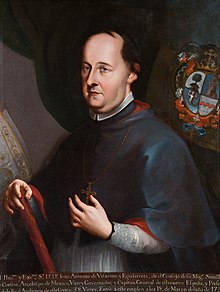Juan Antonio de Vizarron y Eguiarreta
Juan Antonio de Vizarrón y Eguiarreta , (born September 2, 1682 in El Puerto de Santa María near Cádiz , Spain , † January 25, 1747 in Mexico City ) was a Spanish bishop of the Roman Catholic Church and colonial administrator, who served as Viceroy of New Spain officiated.
Life
Origin and church career
Juan Antonio de Vizarrón came from a wealthy and influential family who made their living trading between America and Spain. He embarked on an ecclesiastical career and received the office of Archdeacon of Seville Cathedral . In July 1730 he was appointed Archbishop of Mexico . He traveled to the New World and was inducted into office on May 13, 1731.
Tenure as Viceroy of New Spain
In March 1734, the reigning viceroy, Juan de Acuña, died . For this case, the Real Audiencia of Mexico had received a sealed envelope from Spain in which the successor was determined, the Council of India had chosen the archbishop as successor when Acuña died. In his function as archbishop he directed the funeral services for his predecessor.
Foreign policy
The conflicts with the English , who had settled in what is now Belize , dragged on during Vizarrón's tenure: in 1734, an expedition under the governor Juan Fernández de Sabariego succeeded in arresting several corsair ships with cargo and 28 Englishmen. Another expedition under Manuel de Salcedo failed to recapture the area for the Spaniards. In 1737 the Spaniards were defeated in a dispute with British seagoing ships. The Armada de Barlovento failed to assert itself against the English.
The war against the United Kingdom during Vizarrón's reign also endangered the ports and settlements of the Spanish in Central America. The admirals George Anson and Edward Vernon took Portobelo , defeated the Spaniards in La Guaira and Santiago de Cuba . They were only beaten back at Cartagena (Colombia) . The viceroy not only had to secure the coasts and sea routes in the Pacific, the Gulf of Mexico and the Caribbean for the Spaniards, but also the Spanish outposts in Florida , Puerto Rico, and Hispaniola .
Domestic politics
Domestically, Vizarrón tried to improve internal security and curb rampant crime and mugging.
In 1736, an epidemic called Matlazahuatl broke out, especially among the indigenous population . The disease killed around two thirds of the population. More than forty thousand people died in Mexico City alone and around fifty thousand in Puebla . From a medical point of view, it is still unclear whether it was a variant of yellow fever or chickenpox . As countermeasures and relief measures, the viceroy set up hospitals and called the Virgin of Guadalupe to be the patron saint of Mexico.
In the northwest of the colony, in Baja California , there were renewed Indian revolts , which were put down by Governor Sinaloa.
Late tenure as archbishop
After Vizarrón's tenure in office for six years, the Spanish crown decided in May 1739 to send Pedro de Castro y Figueroa as his successor. Castro arrived in Mexico in July 1740 and was able to take over the business of government.
Juan Antonio de Vizarrón gave up the secular part of his rule and limited himself to his office as Archbishop of Mexico. He held this until his death in January 1747. Vizarrón was buried in the Cathedral of Mexico City.
literature
- Juana Vázquez Gómez: Dictionary of Mexican Rulers, 1325-1997 . Greenwood Publishing Group, Westport CT 1997, ISBN 0-313-30049-6 , pp. 39 ( Google Books ).
- Fernando Orozco: Gobernantes de México . 3. Edition. Panorama Editorial, Mexico City 2004, ISBN 968-38-0260-5 , p. 129-130 ( Google Books ).
Web links
- Biography (spanish)
- Biography (spanish)
- Entry on Juan Antonio de Vizarrón y Eguiarreta on catholic-hierarchy.org
| predecessor | Office | successor |
|---|---|---|
| Juan de Acuña |
Viceroy of New Spain 1722–1734 |
Pedro de Castro y Figueroa |
| personal data | |
|---|---|
| SURNAME | Vizarrón y Eguiarreta, Juan Antonio de |
| BRIEF DESCRIPTION | Spanish bishop of the Roman Catholic Church and colonial administrator |
| DATE OF BIRTH | September 2, 1682 |
| PLACE OF BIRTH | El Puerto de Santa María near Cadiz , Spain |
| DATE OF DEATH | January 25, 1747 |
| Place of death | Mexico city |
